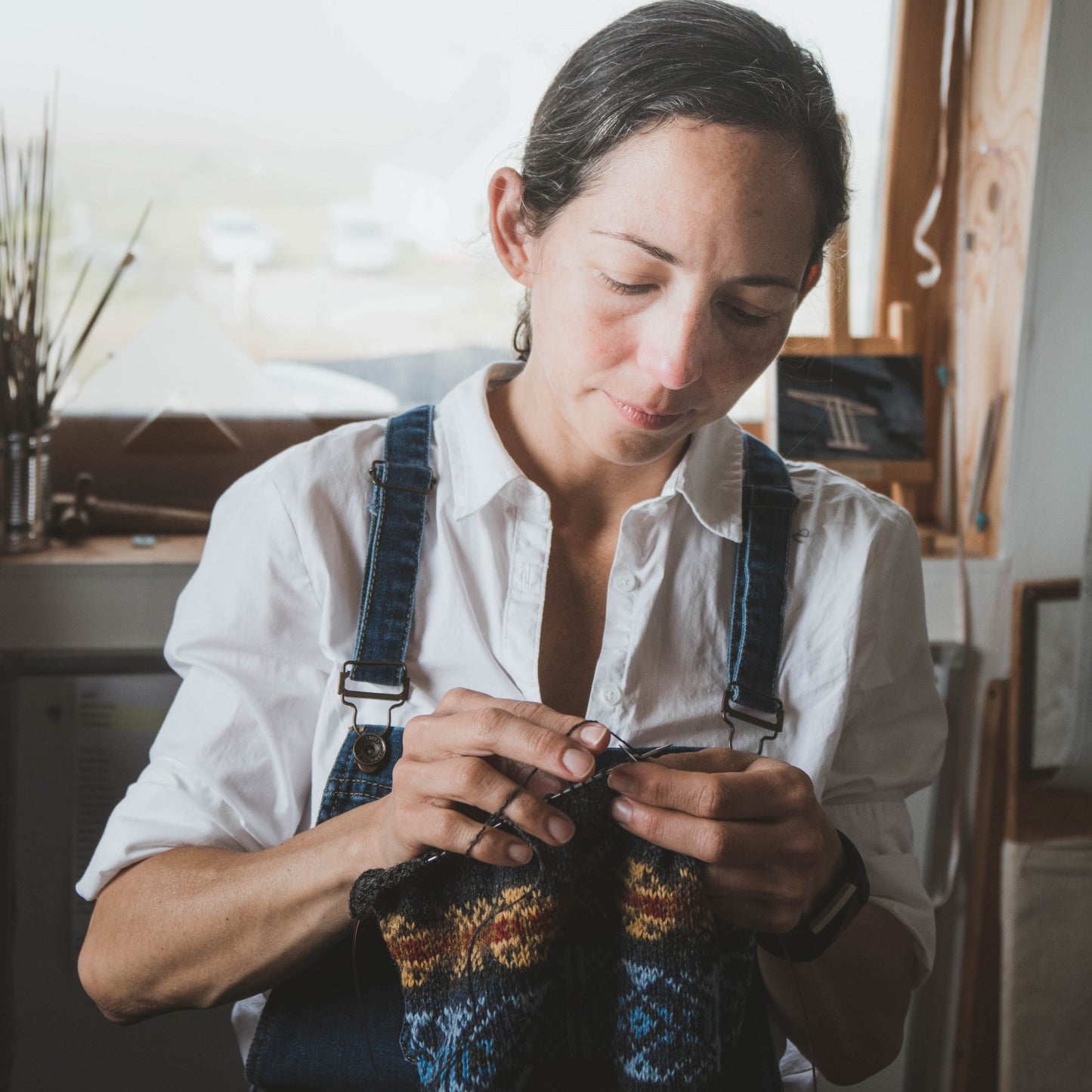Scotland, Mati Ventrillon, Fair Isle Knitting
Selvedge Magazine
Couldn't load pickup availability
Mati Ventrillon is very different from what you might expect of a renowned maker of Fair Isle knitwear; her life story has been one of change and adjustment to widely different circumstances Born in Venezuela, into a mixed Venezuelan, French, German family, she is something of an outsider in the place she has chosen to call home.
“I learnt to see through my mother, who was blind, “she says. “It made me see the world in detail. I had to see for her and be able to observe closely so that I could explain things to her.” Mati’s father also had a disability and once her grandfather a well-known architect and professor at the Central School of Architecture in Caracas died, her family found themselves in straightened circumstances. “I didn’t really fit, as my colleagues at University assumed I had a level of financial stability and status that I didn’t have. It was difficult.” She drew a lot, loved graphics, but studied sociology and then architecture, qualifying in 2001.
She met her husband through Zen Buddhism and when he was offered a position at the Architectural Association, the pair decamped to London. After their son was born, Mati got a job as an architect. “It was very interesting as the practice was very classical and far removed from my kind of architecture. I learnt so much” When her husband saw a colleague’s application for a project in Fair Isle, the couple decided they wanted a new life and without having visited, applied to move there. They were initially rejected and instead undertook a 6 month cycle tour with their young son.
In 2006 the National Trust offered them a second chance, partly based on Mati’s business plan to start a café in the Trust’s lighthouse. “We hadn’t realised that there was no winter trade and that in summer all the accommodation was full board, so it never materialised.” Instead the couple took over a croft and had another child. Mati became a part-time school secretary, learnt to look after sheep and became self-sufficient.
Intrigued by Fair Isle traditions of knitting, Mati applied to the 27 year old knitting Cooperative. To the locals and her own surprise, she turned out to be rather good at finishing garments. By the time the Cooperative folded in 2011, Mati was hooked “Knitting here was always on the verge of disappearing, yet women kept the Island going with it. I couldn’t bear the thought of all the traditions being lost, so I started my own company. When I took my efforts to the Shetland Christmas Fair, it was scary. They examined every piece. They can make or break you. I was so proud when they said wow really good and that Fair Isle should be proud to have me there.”
To make her evolving designs, Mati recruited other knitters. “There are 55 people here, 23 able adults, of whom only 6 are knitters. I had little experience of a small community. I made mistakes. I was too ambitious, too driven and too bossy. I didn’t understand the things I understand now. People here will help you, but they don’t like working for anyone else. Your past doesn’t exist. You start from scratch and prove yourself. There is a massive cultural difference. The nail that sticks out gets hammered.”
Mati has like all the locals, had to turn her hands to different things, in Mati’s case that includes being fire crew at the airport and Island wide. Such independence and resilience doesn’t necessarily make it straightforward to work with others. Mati was keen to employ more people, training up interns, but accommodation is limited on the Island, which meant that any incomers had to live with her in her small house and studio. Her most successful apprentice lived with her for 3 years before leaving to start her own company. Mati is both pleased to have passed on the skills, but sad to lose her star worker.
Mati has adapted local traditional wear, reframing it for contemporary tastes. She uses only the highest quality Shetland wools, spun on Shetland. She researched Fair Isle designs with the late 93 year old Annie Thompson, who could trace her family designs back to the beginning of the 20th century. Mati’s crew neck jumper re-interprets the striped background of an 1860 silk sweater from the George Waterson Museum, (researched by Annie Thompson’s daughter, the social historian Anne Sinclair,) whilst preserving the authentic 19th century Fair Isle motifs.
Mati wasn’t keen on naming her company after herself, but her mentor with Walpole, the business crafted programme, insisted that it was based on her story in the islands, not the islands themselves. After a rough personal year, Mati has been developing her MV Collection, which celebrates the markings of Shetland Sheep. “I was going to label each sweater with the tag of the sheep used.” The pieces look very different and draw on early motifs and colourways. Her hooded, (snood) jumper for example, is inspired by an 1860s knitted cap from the National Museum of Scotland’s Collection. Mati had been hoping to present her MV Collection at the Selvedge World Fair. Covid 19 put a stop to that, but has given her the opportunity to rethink her business.
Historically the islands were the centre of shipping traffic, leading to an exchange of information and people. “Today,” says Mati, “technology is our window to different worlds. I was the first to put Fair Isle kitting online, now I am looking at a new model of connecting people though knitting. I will stay on the island, but I will train people around the world to knit with Shetland wool. Everything will be finished back here by me. Knitting here is mindful. It takes time to absorb the culture, observe and understand. Thinking about the collections takes time to move forward whilst still being connected to the Island’s tradition.”


Share
























